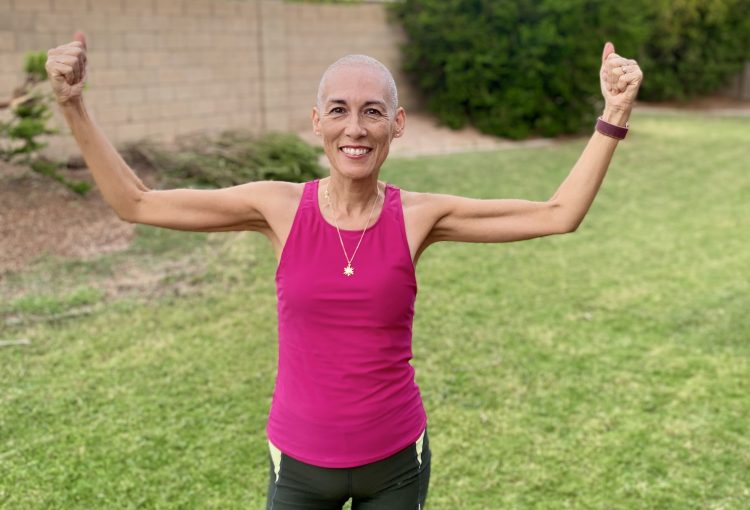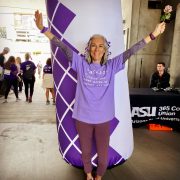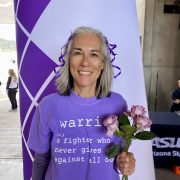For Christine Wells, Traditional Treatments, Lifestyle Changes & Holistic Practices Were the Keys to Fighting Pancreatic Cancer
Contributing Writer
Julia Brabant
February, 2025
Diagnosed: July 25, 2022
Current Status: No sign of cancer since her surgery
Christine Wells’ almost-three-year journey with pancreatic cancer has had its fair share of challenges, from fighting with insurance companies to navigating the emotional side of such a sudden, serious diagnosis. Yet, by exhibiting resilience and resourcefulness and embracing a combination of conventional medical treatments, holistic efforts and lifestyle changes, Christine is currently living cancer-free.
Christine’s diagnosis came in the wake of ongoing stomach pains, with the otherwise fit and healthy then-53-year-old experiencing sharp pains in her abdomen after eating, especially after consuming sugar or junk food. Believing this was a likely result of poor dietary choices, she didn’t think much of it until a few months later, when she suffered the most severe stomach pain she’d ever had.
Christine met with her primary care provider, who felt a hard mass in Christine’s abdomen, prompting a CT scan. The imaging report from the scan showed the presence of a “pseudocyst” on Christine’s pancreas, which is typically a benign, fluid-filled mass.
Christine’s doctor told her the mass likely wasn’t cancerous because only about 1% – 2% of pseudocysts are, but that it may require surgical removal anyway due to its large size. However, after several procedures failed to remove the cyst in its entirety, Christine’s care team recommended she have a biopsy, noting that its characteristics and presentation were not consistent with what they typically saw in pancreatic pseudocysts.
The biopsy showed that the mass was benign, but to be on the safe side, Christine’s doctors sent the sample to a separate medical center for a second opinion. When Christine logged into the institution’s patient portal for an update, she saw that she had “poorly differentiated mucinous adenocarcinoma.”
“I didn’t understand all the medical terminology at the time,” she said, “But I knew ‘carcinoma’ was cancer.”
Doctors said that Christine’s cyst was the size of a grapefruit or softball, and that a cancerous tumor developed from the cyst.
“I’m actually so grateful I had the cyst,” Christine said. “It saved my life by helping them identify the cancer before it spread through my body.”
Doctors determined Christine was “Stage 2A,” meaning her tumor was larger than 4 centimeters but had not yet spread to distant organs. They recommended she see Dr. Erkut Borazanci, M.D., an oncologist and clinical investigator at the HonorHealth Research Institute in Scottsdale, Arizona, which was not far from Christine’s home in Mesa.
After confirming Christine’s diagnosis, Dr. Borazanci, or “Dr. B,” recommended she begin chemotherapy. However, her insurance company denied chemotherapy outright despite Dr. B’s efforts to highlight Christine’s need.
Dr. B encouraged Christine to get the local news media involved and to contact the Arizona governor if the additional media attention didn’t lead to a resolution. While it took considerable outreach and effort, Christine’s insurer eventually reversed its decision, paving the way for nine weeks of chemotherapy using a combination of Abraxane, Cisplatin and Gemcitabine.
Like many people having chemo, Christine dealt with side effects, including blurred vision, dizziness, mouth sores, fatigue, constipation, and tightness and pain in her chest. The worst part, though, was the near-constant anxiety and uncertainty she felt about whether her body would respond.
Unfortunately, scans showed no change after chemo, and doctors identified a concerning spot on Christine’s liver, too. An MRI showed that the liver spot was a cyst, rather than a cancerous mass, but it also showed worsened hypermetabolism in her pancreas.
Christine’s team recommended she have more chemo using a different drug, FOLFIRINOX. This meant she had to go home with an infusion pump to have more chemo at home, which proved difficult to manage, particularly at night. This time around, she experienced different side effects, including nausea and neuropathy in her fingers and hands. Yet, after nine weeks of treatment, this time, scans revealed a considerable decrease in the size of Christine’s tumor.
“I was so grateful I still had a fighting chance,” she said. “That meant I could move on to the next stage – radiation.”
Christine had radiation five days a week for six weeks and took chemotherapy pills simultaneously to enhance the radiation’s effectiveness. While she experienced minor side effects with the oral chemotherapy, all in all, she found it much more manageable than her previous chemo regimens.
Subsequent scans showed that Christine’s tumor shrank even more after the radiation and oral chemo. When her radiation oncologist, Dr. Steven Sckolnik, M.D., determined her cancer hadn’t metastasized, he scheduled her for surgery with Dr. Aryan Modasi, M.D. Christine recalls Dr. Sckolnik telling her she was lucky to reach this milestone, with less than 10% of pancreatic cancer patients in her position ever qualifying for surgery.
Christine wound up having a distal pancreatectomy in March 2023, but her surgeon warned her ahead of time that he may not be able to remove all of the cancer due to its proximity to her gastroduodenal artery and superior mesenteric and aortal veins.
“I was a little disheartened hearing that; that was a hard day,” Christine said. “But I told myself, ‘I’ve already beaten the odds,’ so I was hopeful.”
The surgery was difficult, lasting more than five hours. Dr. Modasi performed the procedure robotically, removing the neck, body and tail of Christine’s pancreas along with her spleen and 20 lymph nodes. After reviewing Christine’s pathology reports, the doctor delivered the best news she’d heard in recent memory, telling her she’d had a “complete response to treatment.”
“I cried tears of joy,” Christine said. “For me, that meant I was cancer-free.”
While Christine’s doctor told her you can never “cure” pancreatic cancer, he assured her that her surgery had the best possible outcome and that it was rare to see such positive results. Now, about two years later, Christine continues to see Dr. B every three months for follow-ups, and so far, all scans and bloodwork have come back clear. While Dr. B recommended Christine have chemotherapy post-surgery, she ultimately decided not to do so.
Embracing Holistic Efforts & Lifestyle Changes
Christine incorporated a range of holistic efforts and lifestyle approaches to support her cancer treatment and recovery. She began reading everything she could about the healing power of food and gave her diet a major overhaul, cutting out sugar and processed foods while ramping up her intake of fruits, vegetables and other whole foods.
Eating healthy became such a key focus for Christine that she began blogging about her efforts, keeping a “Tina’s Cancer-Fighting Recipes” blog detailing her journey and highlighting some of her favorite cancer-fighting recipes. She’s also working on a cookbook on the same topic, sharing the recipes and food wisdom she’s developed to help others fight cancer.
Christine has also worked hard to adjust to the emotional effects of a cancer battle, finding that the fear and anxiety she experienced as a result of it was manifesting in physical symptoms in her body.
“I knew if I didn’t make my mind stronger, I’d die,” she said. “I was so overwhelmed I couldn’t sleep; I’d barely slept in weeks.”
A turning point came when Christine tuned into a podcast by Dr. Bruce Lipton entitled “The Power of Our Mind and How Stress Compromises Our Health.” The podcast discussed how filling one’s mind with positive thoughts and creating new “programming” within one’s subconscious can improve emotional health and well-being.
She also began practicing mindful breathing, therapeutic coloring and embracing the power of positive affirmations, finding that selecting a few that resonated and saying them aloud each day helped keep scary thoughts at bay. Christine had also begun practicing “laughter yoga” on the recommendation of a friend back when she switched her original chemotherapy regimen over to FOLFIRINOX. It’s something she continues to practice regularly, finding that it boosts her mood by triggering serotonin and oxytocin and strengthens her immune system by increasing her oxygen intake.
“Laughter yoga helped me tremendously. I learned that your body doesn’t know the difference between real laughter or fake laughter, and it triggers your brain to release all those feel-good chemicals that will heal your body and make you feel great!” she said. “Of all the things I did, laughter was one that helped me the most. It allowed my body to heal.”
Along with these practices, Christine also began embracing the healing power of plants, filling her home with as many as she could to purify the air and improve her emotional state. She also found that spending time in nature boosted her mood, finding that the slower pace of life that came after her cancer diagnosis gave her more time to “stop and smell the roses,” so to speak.
“Cancer really opened my eyes to the beauty of the world all around me,” she said. “I have so much more gratitude for everything in my life – each day is a such a gift when we can see and appreciate the beauty all around us.”
Connecting With the Pancreatic Cancer Community
Christine also began interacting with the greater pancreatic cancer community, participating in several Purple Stride events and attending the Seena Magowitz Foundation’s “Steppin’ Up Against Pancreatic Cancer” fundraiser at Arizona State University in November 2024.
She plans to attend even more events in the future, hoping that her own experiences will inspire hope in people facing similar hardships.
“I learned so much through my cancer experience,” Christine said. “It taught me the joy of living in the present moment, because the future was so uncertain…cancer was my greatest teacher.”
Christine also warns others facing a pancreatic cancer diagnosis to avoid doing too much online research and instead shift their focus toward the things they can control.
“There’s a misconception that pancreatic cancer is a death sentence,” she said. “So much is out of your control, but there’s also a lot you can control, like diet, meditation, strengthening your mind…it’s all very helpful.”
Christine also makes a point to focus on the positive and keep a gratitude journal; practices she finds extremely beneficial.
“I had to retrain my brain to be more positive and kinder to myself. I lived most of my life seeking approval through others, seeking validation through my work and achievements. I was doing what others wanted me to do, not what I wanted to do,” she said. “But cancer taught me to love myself better. I’ve learned that there’s always something to be grateful for, even on a bad day.”
Christine continues to monitor her condition closely and has shown no sign of cancer since her surgery in March of 2023.





